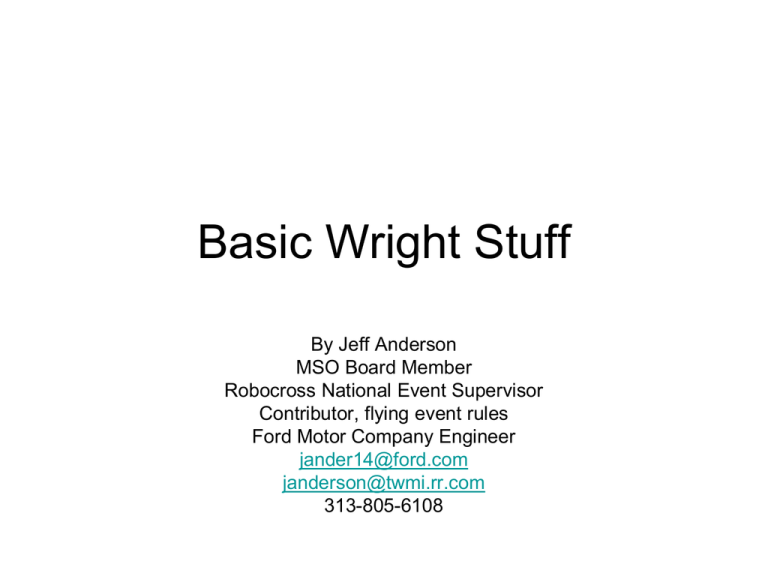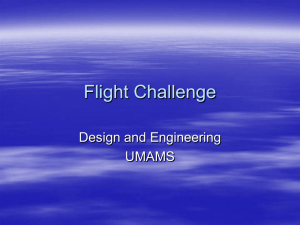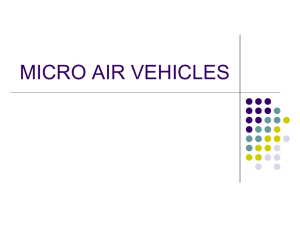HERE - VANHECKE SCIENCE.COM
advertisement

Basic Wright Stuff By Jeff Anderson MSO Board Member Robocross National Event Supervisor Contributor, flying event rules Ford Motor Company Engineer jander14@ford.com janderson@twmi.rr.com 313-805-6108 Overview • • • • • • • What the event is about Critical takeaways BRIEF overview of rules Resources Building Record Keeping First flights, initial trim What Wright Stuff is about • This event isn’t about designing an airplane. • It IS about collecting data and evaluating it to optimize a complex system • While it isn’t about designing a plane, unless you can build a plane that flies, you can’t get to the meat of the event, so I’ll spend a lot of time on that. • So, why an airplane? Frankly because they are a complex non-linear system. Besides, they’re FUN! • Note, while the point is test and eval, there are lots of opportunities to explore math and science at all stages of building and flying! • http://www.youtube.com/watch?v=Wqt-FsekeqE Critical takeaways • WARNING: these planes are fragile, you will break it, others will break it even easier if you let them, sometimes you break it intentionally, GET OVER IT! • Rule 1, build the plane as light as the rules allow • Rule 2, make sure your plane doesn’t weigh too much • Rule 3, go back and read rules one and two! • Rule 4, build accurately, spend time preparing materials, making jigs & patterns, etc. Build fast. • Rule 5, take LOTS of data, which means fly lots! Rules • READ them yourself, have the students read them, closely! • Don’t push the dimensions, the extra performance you get from a 1 mm longer chord cannot offset being tiered! • BIG CHANGE, you can make your own props!! It isn’t hard, you’ve been doing it in helicopter for four years!! • It’s a monoplane, don’t bring a bi-plane • Size: wing 50 by 8 cm max, stab 30 by 6 cm max, prop 24 cm max • Masses: plane 8.00 gm min, motor 2.00 gm max • Covering, make sure you have that non-white/non-transparent panel, it’s a silly bonus to miss!! • Flight log, go back to critical takeaways, make sure your students have it at the competition, silly penalty to take! • Two flights in 8 minutes, second only has to launch within window • Longest flight wins Resources • Where to find help? – Everything I cover here and more is on the internet somewhere, the National SO page is a good starting point – I monitor several discussion boards on the net and respond to e-mail questions – Check you local AMA clubs, especially those focusing on free flight Resources • Building Tools, must have – A flat building board, able to take pins and covered with wax paper, I use foam insulation board – Sharp knives with lots of spare blades – A good metal edge rule/straight edge – Lots of pins & scrap balsa blocks – A good scale accurate to 0.01 gm, cheap (less than $20) electronic ones available on the net or build your own for less – Wire cutters and pliers Resources • Building tools, nice to have – Precision micro super glue applicator, two pins stuck through a stick at an angle to come together at their ends – Balsa stripper – A six inch piece of 0.063 music wire – Mat board or writing tablet backs, not poster board, for jigs – ¼ inch thick balsa sheets for jigs – Misc square blocks for jigs Resources • Building materials – A complete kit, easy way to get everything to build 1 or 2 planes, costly – OR… – Balsa, 1/32, 1/16, and ¼ inch thick sheets, or suitable width sticks, light to medium density – Covering, indoor mylar, tissue, grocery store bags – Glue, Superglue (also called: cyanoacrylate or CA) or balsa cement – If using CA, instant setter – Wire, 0.020 diameter – Props – Prop hanger Resources • Flying – Necessary: • Rubber, lots, FAI TAN Sport or preferably Super Sport, various thicknesses, but 3/32 is a good starting point • O-rings, I slice them from teflon tubes I scrounge • Winder, these planes take 1500 or more turns to fly well! • Stop watch, NOT your cell phone, you’ll get DQ’d • Your flight LOG and a pen/pencil! • A good carrying/storage box – Darned Nice to have: • • • • Stooge to hold the plane, remember, they break An anchor to wind motors off the plane Torque Meter Repair Kit, CA, setter, knife, spare covering, spare balsa Internet Links • • • • • • https://soinc.org/sites/default/files/uploaded_files/ScienceOlympiad5.0.pdf http://scioly.org/wiki/index.php/Wright_Stuff http://freeflight.org/education/science_olympiad/ https://bsmsscienceolympiad.wikispaces.com/Wright+Stuff https://www.scribd.com/doc/36303184/Penny-Plane-by-John-Barker http://freeflight.org/jlf/beginners_corner/whammy_series/double_whammy/d w_article.pdf Building • Overview – – – – – – – – – – – Select a plan Gather and prepare materials Make jigs Make tissue tubes Make wing and tail frame Cover wing and tail Set dihedral Attach wing and tail posts Make motor stick and tail boom Find Balance Point, glue wing tubes Check settings, go fly! Select Plan • Plans come with kits, and are available on the internet. Make sure they comply with the rules or adjust accordingly • Plans have two key elements – Drawing of plane showing dimensions and arrangement of all parts – A bill of materials, often missing, you probably will have to make it yourself Select Plans: The Drawing Select Plan: Bill of Materials Finny 09 by Bill Gowen PLANNING DATA Part Name wing spars wing ribs stab spars stab ribs wing fins stab fins motor stick tail boom wire prop hook rubber hook,wire wing posts prop groc bag covering, wing groc bag covering, horz stab groc bag covering, wing fin groc bag covering, stab fin glue, tissue tubes, etc(est) total wt estimate qty length 2 7 2 5 2 2 1 1 1 1 2 15.5 4 7.75 2.25 7 4.5 10 12 1.5 0.75 4 1 1 2 2 15.5 7.75 4 2.25 width thickness 0.009375 0.0625 0.0625 0.0625 0.03125 0.03125 0.03125 0.03125 0.0625 0.0625 0.3125 0.1875 0.375 0.25 0.1875 0.125 0.02 0.02 0.0625 0.0625 4 2.3125 2 1.5 volume (in3) 0.018164 0.109375 0.015137 0.010986 0.054688 0.527344 0.9375 0.28125 0.000471 0.000236 0.03125 62 17.92188 16 6.75 rec density (lb/ft3) 8 8 5 5 6 6 8 5 489.6 489.6 10 8 8 8 8 wt (grams) 0.038 0.230 0.020 0.014 0.086 0.831 1.970 0.369 0.061 0.030 0.082 1.750 0.320 0.092 0.083 0.035 0.500 6.513 gm/m2 gm/m2 gm/m2 gm/m2 Prepare materials • Select straight parts from your sticks or strip your own from sheet to match plan, make sure you check weight against the bill of materials, stiff and straight, cut slightly long • Cut ribs, lots, exactly to length, select the best that weigh the bill of materials amount • Cut covering with a one inch margin over the wing and tail size • Cut multiple motor sticks & tail booms, select the best, stiffest, to weight on bill of materials • If building on plan, tape to building board, cover with wax paper, otherwise just cover board with wax paper. • Have glue, pins, scrap blocks to hand Cutting Ribs Prepare Jigs • You can build without jigs, just not as well or as fast. • Spending time on accurate jigs greatly speeds building good planes Example: wing jig Prepare Jigs Prepare Jigs Prepare Jigs, prop Student built prop http://indoornewsandviews.com/2014/01/ http://freeflight.org/jlf/beginners_corner/whammy_s eries/double_whammy_pennyplane/dwp_article.pdf Tissue Tubes NO CA HERE! Glue one edge like a flag Lots of glue Roll up squeezing glue through layers wiping off excess LET DRY OVERNIGHT! Slide off with fingernails Build wing and tail frame • Pin spars to plan or jig. DON’T pin through balsa! • Dry fit ribs in position • Check rib position for accuracy • Glue with CA using microapplicator • Let dry or apply accelerator. • Remove from building board Cover Wing While example is tissue, this approach works for any covering Once you drop it, don’t try to move it! Any spray glue works Cover wing Smooth down one edge Roll down Smooth down second edge edge Trim, use a fresh, sharp knife Set Dihedral Cut halfway through Crack at cut Fixture to hold angle Same process for left wing washin Use the microcementer cut Prop up per plan Make up Motor Stick and Tail Boom Balance Point & Tissue Tubes Distance from cg to post per plan, may adjust after test Balance, mark cg Posts Parallel Assemble and check Raise leading edge over trailing edge per plan Adjust based on testing For tail, lower leading edge over trailing edge Again, adjust based on testing Note difference leading edge to trialing edge Washin Note stab tilt to wing for turn Trials and Record Keeping • I can show you how to build a plane, even hand you one of mine disassembled, but without practice and data collection you won’t be able to fly it! Plan LOTS of practice time • This event is PRIMARILY about data collection and evaluation. Minimal flight logs pass the requirement, but miss the point! 2009 Wright Stuff Div B Flight Log Flying Session Date: Room Size: Airplane being tested, brief description Flight Wing Tail Number setting setting Ceiling Ht: Propellor Pitch Motor Size Temperature: Max Turns Backoff Turns Max Torque Backoff Torque Air: Max Height Flight Turn Diameter Time Flight Behavior Other comments 1 2 3 4 5 6 7 8 9 10 11 12 13 14 15 16 17 18 19 20 Samuel Pierpont Langley Middle School Students: Orville Wright Wilbur Wright Flying, misc hints/tips • Rubber motor – Lube your motors – WIND THEM! These 2 gm motors will take well over 1600 turns before breaking. I fly my 0.075 motors on 2000 turns! – BREAK A MOTOR OR TWO to know when it breaks! • Pre Flight (develop a checklist, use it every flight) – Assemble plane – Check settings, use plan recommendation as start point. – Left wing should have leading edge a little high (wash-in), right wing flat – Stab should tilt wrt wing so left side high – Prop should point SLIGHTLY down and left – Check for anything broken, fix it. – Set plane in stooge. – Test fly with motor but no winds, it should glide gently to floor.\ – Recheck settings Flying, misc hints/tips • Winding – Wind off the plane using a hook, put the knot by the hook – Stretch 3-4 times length, start winding stretched, about 500 to 600 turns start coming in to end at motor stick length with 1000 plus turns – Transfer the motor to the plane • Have one partner hold the plane, lock the propellor and present it to the winding partner, watch the tail! • Winding partner, without touching plane (much) take motor off winder, put it on prop hook. • Then take other end of motor off anchor and put it on tail hook. Flying, misc hints/tips • Launch – To start, launch at shoulder height, when you can consistently hit the ceiling, launch close to floor – Give the plane only a GENTLE push in direction of flight – Launch level – Time and observe flight and note behavior Possible behaviors (assuming you WOUND that motor) NOTE, CHANGE ONE THING AT A TIME, SMALL AMOUNTS • It flys pretty good. – Rare, but it happens. – Start changing factors small amounts, one at a time to improve times. – COLLECT DATA for future reference • It dives quickly to floor, if you wound the motor, try one of the following – – – – Raise the leading edge of the wing Raise the trailing edge of the stab Move the cg back with ballast Make sure you didn’t wind the motor backwards!! • It tries to fly, but keeps repeating nose up, slows down, drops nose, repeat, you are stalling – Move the cg forward with ballast – Lower the leading edge of the wing – Raise the trailing edge Possible behaviors (assuming you WOUND that motor) • It climbs strongly, nose constantly pointing more up till the plane hangs on the prop than stalls hard – Add some down thrust to the prop hanger • It flys OK, but just doesn’t want to climb. – – – – Try more winds Try a fatter motor Try a lower pitch prop Add a little left wing wash in







